Key Takeaways
- SpaceX sent 28 Starlink satellites into orbit on October 3, 2025.
- The Falcon 9 launch broke Vandenberg’s yearly orbit mission record.
- Reusable rockets helped speed up launch operations.
- This boost in launch cadence supports national security needs.
On October 3, SpaceX lit the engines of a Falcon 9 rocket. It rose from Vandenberg Space Force Base at dawn. This Falcon 9 launch carried 28 Starlink satellites into low Earth orbit. In doing so, it smashed the base’s previous record for annual orbital missions.
This success shows how SpaceX’s reusable rocket design can speed up operations. Moreover, it highlights a shift in the U.S. space industry toward rapid, high-cadence launches. As a result, more missions can lift off each year.
Why the Falcon 9 Launch Matters
A Falcon 9 launch now sets the pace for orbital missions. First, it proves reusable rockets can fly often and land safely. Next, it delivers vital communications satellites for global internet service. Finally, it boosts readiness for defense and national security needs.
By reusing the first stage, SpaceX cuts costs and time between missions. Thus, teams can prepare rockets faster. In addition, satellite operators can deploy networks on tighter schedules. Meanwhile, government agencies benefit from quick access to space.
How Falcon 9 Launch Drives Reusable Rocket Power
SpaceX pioneered landing and reflying rocket boosters. During the Falcon 9 launch on October 3, the booster touched down on a drone ship. Then, teams inspected and refurbished it for future flights. Because a Falcon 9 launch can reuse stages, costs fall and availability rises.
Moreover, each successful flight teaches engineers how to refine designs. Consequently, rockets become more reliable and simpler to maintain. Experts say each Falcon 9 launch reduces costs by millions of dollars. This progress attracts more satellite customers and boosts industry competition.
Fast Launch Cadence and National Security
Rapid launch schedules support national security in multiple ways. First, they ensure quick replacement of satellites damaged or lost. Second, they allow fast response to emerging threats. Third, they keep vital communication networks intact.
In this context, the Falcon 9 launch plays a critical role. For example, if a surveillance satellite fails, a backup can lift off within weeks. Thus, military and intelligence agencies maintain uninterrupted coverage. Moreover, allies can rely on U.S. launch services for their own security needs.
Setting Records and Eyes on the Future
With 28 satellites deployed, SpaceX now logged more missions this year than any previous year at Vandenberg. However, the company isn’t stopping here. Next missions will carry more Starlink satellites and other commercial payloads.
Looking ahead, SpaceX plans to increase its launch tempo even further. In addition, new rocket models may debut in the coming years. As demand grows, Vandenberg will see more activity. Local communities might benefit from job growth and economic development.
Meanwhile, the global space race heats up. Other companies and nations are developing reusable launch vehicles. Thus, competition will spur further innovation and cost cuts. Ultimately, the push for high-cadence launches may transform how we use space.
Conclusion
The October 3 Falcon 9 launch at Vandenberg demonstrates a new era in spaceflight. It blends reusable rocket technology with an urgent need for fast missions. As a result, satellite networks expand quicker and national security gains flexibility. Looking forward, faster, cheaper, and more frequent launches will shape our future in orbit.
FAQs
What makes a Falcon 9 launch unique?
A Falcon 9 launch uses a reusable first-stage booster that lands back safely. This design cuts costs and allows faster turnaround between flights.
How many satellites flew on this mission?
This flight deployed 28 Starlink satellites into low Earth orbit to expand global internet coverage.
Why are rapid launches important for security?
Fast launches let agencies replace or add satellites quickly. This improves communication, surveillance, and defense readiness.
What’s next for SpaceX at Vandenberg?
SpaceX plans more Falcon 9 launches to deploy Starlink and commercial payloads. Future efforts aim for even higher launch rates.

